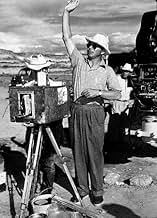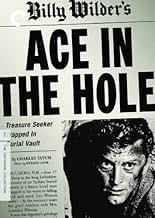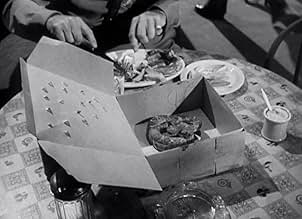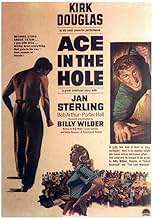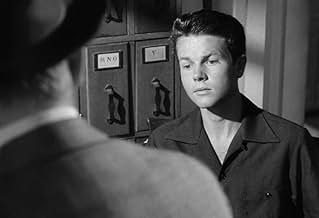CALIFICACIÓN DE IMDb
8.1/10
41 k
TU CALIFICACIÓN
Un ex-periodista frustrado atrapado trabajando para un periódico de Albuquerque explota una historia sobre un hombre atrapado en una cueva para reavivar su carrera, pero la situación rápidam... Leer todoUn ex-periodista frustrado atrapado trabajando para un periódico de Albuquerque explota una historia sobre un hombre atrapado en una cueva para reavivar su carrera, pero la situación rápidamente se convierte en un circo fuera de control.Un ex-periodista frustrado atrapado trabajando para un periódico de Albuquerque explota una historia sobre un hombre atrapado en una cueva para reavivar su carrera, pero la situación rápidamente se convierte en un circo fuera de control.
- Dirección
- Guionistas
- Elenco
- Nominado a 1 premio Óscar
- 5 premios ganados y 3 nominaciones en total
Robert Arthur
- Herbie Cook
- (as Bob Arthur)
Roy Regnier
- Nagel - New York Editor (replaced by Richard Gaines)
- (escenas eliminadas)
Oscar Belinda
- Barker
- (sin créditos)
Opiniones destacadas
10zinkster
One of Billy Wilder's great movies, with a superb acting job by Kirk Douglas as the cynical, glory-seeking and even desperate reporter whose only goal is get back in the limelight by regaining his former big-city news desk job.
The idea of such a newspaper reporter manipulating events to stretch out a story at the expense of and disregard for the victim still seems nearly inhuman, but Douglas' performance makes it instantly believable. The story scenario in which locals, then passers-by and finally distant tourists gravitate to and then make a festival or circus out of the event (the film was also released under the title "The Big Carnival") is supported by the real events on which the story was most likely based: the West VA mine disaster in 1925 that trapped miner Floyd Collins and was reported for 17 days, much as in the film, by local newspaperman Skeets Miller, who crawled into the mineshaft for face-to-face interviews with the trapped and doomed Collins.
This movie fits nicely into the Film Noir genre, although it takes place largely under the hot, harsh glare of the Arizona sun, highlighting the sweat and grime visible on the characters' skin and creating a visual metaphor for the sorry state of their souls. I wonder if Henri-Georges Clouzot saw this film before he began filming "The Wages of Fear," because the visually pervasive atmosphere of sweat and filth and opportunism are equally present in both.
The idea of such a newspaper reporter manipulating events to stretch out a story at the expense of and disregard for the victim still seems nearly inhuman, but Douglas' performance makes it instantly believable. The story scenario in which locals, then passers-by and finally distant tourists gravitate to and then make a festival or circus out of the event (the film was also released under the title "The Big Carnival") is supported by the real events on which the story was most likely based: the West VA mine disaster in 1925 that trapped miner Floyd Collins and was reported for 17 days, much as in the film, by local newspaperman Skeets Miller, who crawled into the mineshaft for face-to-face interviews with the trapped and doomed Collins.
This movie fits nicely into the Film Noir genre, although it takes place largely under the hot, harsh glare of the Arizona sun, highlighting the sweat and grime visible on the characters' skin and creating a visual metaphor for the sorry state of their souls. I wonder if Henri-Georges Clouzot saw this film before he began filming "The Wages of Fear," because the visually pervasive atmosphere of sweat and filth and opportunism are equally present in both.
The cynical, unethical and unscrupulous journalist Charles 'Chuck' Tatum (Kirk Douglas) arrives in a small New Mexico newspaper asking for a chance. He was fired from famous newspapers because of drinking problem, lying and even for having an affair with the wife of one of his bosses. His real intention is to use the small newspaper as a "swimming board" to a bigger one. After one year without a bang news and totally bored, Chuck travels with a younger reporter to make the coverage of a matter about rattlesnakes. When they arrive in an isolated gas station, he is informed that a man called Leo Minosa (Richard Benedict) is trapped alive in an old Indian mine in a nearby place called Mountain of the Seven Vultures. Chuck manipulates the local corrupt sheriff, the engineer responsible for the rescue operation and Leo's wife Lorraine Minosa (Jan Sterling), and a rescue that could be made using a simple and common process in twelve hours, lasts six days using a sophisticated drilling system and creating a circus in the previously desert place. Everybody profits with the accident except the victim.
Movies about manipulation of people are usually excellent. I remember Costa-Gravas' "Mad City (1997), Barry Levinson's "Wag the Dog (1997)", Howard Hawks' "His Girl Friday (1940)", and even the recent real case of the chemical weapons. Yesterday I saw "Ace in the Hole" for the first time and I really was impressed how this film is amazingly real and updated. There are elements present in every modern society, such as: the powerful sheriff very corrupt, like most of the worldwide members of the governments; the press, interested in selling news only; the victim used for other interests greater than rescuing him; and the people, completely manipulated and with very short memory. Kirk Douglas is amazing in the role of a nasty reporter. I do not understand why this movie is not in the IMDb Top 250. My vote is ten.
Title (Brazil): "A Montanha dos Sete Abutres" ("The Mountain of the Seven Vultures")
Movies about manipulation of people are usually excellent. I remember Costa-Gravas' "Mad City (1997), Barry Levinson's "Wag the Dog (1997)", Howard Hawks' "His Girl Friday (1940)", and even the recent real case of the chemical weapons. Yesterday I saw "Ace in the Hole" for the first time and I really was impressed how this film is amazingly real and updated. There are elements present in every modern society, such as: the powerful sheriff very corrupt, like most of the worldwide members of the governments; the press, interested in selling news only; the victim used for other interests greater than rescuing him; and the people, completely manipulated and with very short memory. Kirk Douglas is amazing in the role of a nasty reporter. I do not understand why this movie is not in the IMDb Top 250. My vote is ten.
Title (Brazil): "A Montanha dos Sete Abutres" ("The Mountain of the Seven Vultures")
10castolon
The movie very closely parallels the real events of January 30 to February 16, 1925 in terms of the general story line. There are some significant differences concerning the actions of the characters.
Floyd Collins, a cave explorer working alone (not a real good idea), was trapped in Sand Cave KY, near Mammoth Cave. He was not looking for treasure, but for a new cave suitable for commercializing to produce income in an economically depressed region...and this was before the Depression occurred.
He became trapped on the way out of the cave by a 27 lb. rock which rolled onto his leg in a narrow crawlway. The configuration was such that it could not be moved enough to get his foot past.
When he failed to return home, the family went searching and quickly found him only 150' inside the cave.
A huge rescue effort was mounted and a cub reporter, Skeets Miller, from Louisville KY showed up to cover the story. It became one of the three most widely broadcast events of the time. Besides the extensive newspaper coverage, the relatively new medium of commercial radio riveted listeners with hourly accounts. It quickly became the first media circus ever seen.
Because of the print and radio coverage people began flocking to the site. A carnival atmosphere did indeed spring up around the cave. The state police and National Guard were called out by the governor to control the chaos and the more than 20,000 onlookers. The similarity between the real event and the movie on this account are likely nearly identical.
As in the movie, a decision was made to drill a shaft and, also as in the movie, the rock was fairly unstable and prone to collapse from the pounding of the cable tool drilling rig. The longer the effort went on, the more unstable the cave passage became.
Unlike Kirk Douglas' character in the movie, Skeets Miller served a most honorable role. Due to his small build he became one of very few persons able, and eventually the only one willing, to enter in an attempt to deliver food and water to Collins. He received a Pulitzer Prize for his reporting. Also unlike the movie, there was no manipulation of the event to delay the rescue, but there was considerable disagreement over how to best do it. Area coal miners made the initial attempts and the event concluded with the above-mentioned shaft.
Collins was presumed to have died 3 days before rescuers reached him. Because the conditions were so unstable, the body was left in the cave. The family was able to remove him about 80 days afterward for a proper burial. Later, his glass-topped casket was returned to the now-commercial cave as a tourist attraction. It was removed once again, and finally, in 1989.
In 1982, a definitive account of the event was published in the book 'Trapped!'. A most informative read.
In a take-off of the 'Free Tibet' bumper stickers, vehicles are occasionally seen with a 'Free Floyd Collins' sticker.
Floyd Collins, a cave explorer working alone (not a real good idea), was trapped in Sand Cave KY, near Mammoth Cave. He was not looking for treasure, but for a new cave suitable for commercializing to produce income in an economically depressed region...and this was before the Depression occurred.
He became trapped on the way out of the cave by a 27 lb. rock which rolled onto his leg in a narrow crawlway. The configuration was such that it could not be moved enough to get his foot past.
When he failed to return home, the family went searching and quickly found him only 150' inside the cave.
A huge rescue effort was mounted and a cub reporter, Skeets Miller, from Louisville KY showed up to cover the story. It became one of the three most widely broadcast events of the time. Besides the extensive newspaper coverage, the relatively new medium of commercial radio riveted listeners with hourly accounts. It quickly became the first media circus ever seen.
Because of the print and radio coverage people began flocking to the site. A carnival atmosphere did indeed spring up around the cave. The state police and National Guard were called out by the governor to control the chaos and the more than 20,000 onlookers. The similarity between the real event and the movie on this account are likely nearly identical.
As in the movie, a decision was made to drill a shaft and, also as in the movie, the rock was fairly unstable and prone to collapse from the pounding of the cable tool drilling rig. The longer the effort went on, the more unstable the cave passage became.
Unlike Kirk Douglas' character in the movie, Skeets Miller served a most honorable role. Due to his small build he became one of very few persons able, and eventually the only one willing, to enter in an attempt to deliver food and water to Collins. He received a Pulitzer Prize for his reporting. Also unlike the movie, there was no manipulation of the event to delay the rescue, but there was considerable disagreement over how to best do it. Area coal miners made the initial attempts and the event concluded with the above-mentioned shaft.
Collins was presumed to have died 3 days before rescuers reached him. Because the conditions were so unstable, the body was left in the cave. The family was able to remove him about 80 days afterward for a proper burial. Later, his glass-topped casket was returned to the now-commercial cave as a tourist attraction. It was removed once again, and finally, in 1989.
In 1982, a definitive account of the event was published in the book 'Trapped!'. A most informative read.
In a take-off of the 'Free Tibet' bumper stickers, vehicles are occasionally seen with a 'Free Floyd Collins' sticker.
There are some films that when you see them you ask why they aren't available to rent or own. This is one of them. I had the fortune of seeing this hidden gem on the big screen and was pleasantly surprised.
With Kirk Douglas playing a Reporter whose been around the block, always looking for a shortcut, comes across an opportunity to exploit a man caught in a mine shaft. I have read where critics had considered the circus atmosphere of the the film unrealistic. It seems Mr. Wilder got the last laugh. If you are interesting in great dialogue and good story telling, I suggest you find this
With Kirk Douglas playing a Reporter whose been around the block, always looking for a shortcut, comes across an opportunity to exploit a man caught in a mine shaft. I have read where critics had considered the circus atmosphere of the the film unrealistic. It seems Mr. Wilder got the last laugh. If you are interesting in great dialogue and good story telling, I suggest you find this
Saw this films years ago and it's still gripping.Mr.Wilder seldom did films that gripped the human condition like this one.After this movie flopped he stuck to screen adaptions of stage hits through most of the fifties.Both director and star,Kirk Douglas really delivered a stinging expose of media hype and manipulation of the newspaper business.Herein,burned out reporter Douglas chances on a man trapped in a cave and ruthlessly exploits it for his own gain.There's no softness here,even the leading lady (played wonderfully by Jan Sterling)is as hard as Douglas.The scenes of all the gawkers showing up,complete with carnival,are outright creepy.There's even a cheesy country western singer plunking a guitar and singing about poor Leo,(the trapped man.) The only sympathetic person is poor Leo's mom who continually prays for his release.Definitely a film for lovers of great movie drama.
¿Sabías que…?
- TriviaAfter the film was released, it got bad reviews and lost money. The studio, without Billy Wilder's permission, changed the title to "The Big Carnival" to increase the box office take of the film. It didn't work. On top of that, Wilder's next picture, Infierno en la tierra (1953), was a hit and he expected a share of the picture's profits. Paramount's accountants told him that since this picture lost money, the money it lost would be subtracted from the profits of "Stalag 17".
- ErroresWhen Lorraine and Chuck are talking out in front of Minosa's store by the gas pumps, reflections of the crew moving around behind the camera can be seen in the store windows.
- Citas
Charles Tatum: Bad news sells best. Cause good news is no news.
- ConexionesFeatured in AFI Life Achievement Award: A Tribute to Billy Wilder (1986)
- Bandas sonorasThe Hut-Sut Song
(uncredited)
Written by Leo Killion, Ted McMichael and Jack Owens
Sung by Richard Benedict and Kirk Douglas
Selecciones populares
Inicia sesión para calificar y agrega a la lista de videos para obtener recomendaciones personalizadas
Detalles
Taquilla
- Presupuesto
- USD 1,800,000 (estimado)
- Total a nivel mundial
- USD 2,300,087
- Tiempo de ejecución
- 1h 51min(111 min)
- Color
- Relación de aspecto
- 1.37 : 1
Contribuir a esta página
Sugiere una edición o agrega el contenido que falta


